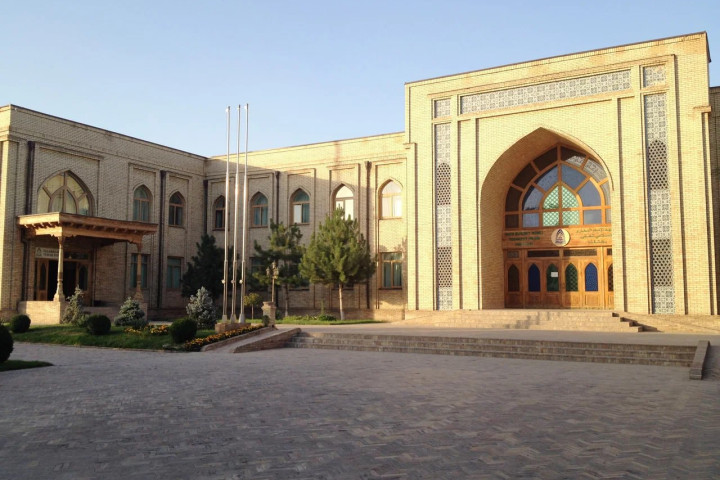
Māturīdism and Philosophy: Nūr al-Dīn al-Ṣābūnī (d. 580/1184) and the attribute baqāʾ
Dr. Angelika Brodersen,
Research Associate at Ruhr-University Bochum/Germany
I. Nūr al-Dīn al-Ṣābūnī and Faḫr al-Dīn al-Rāzī
“While I was spending that night in this apartment with al-Nūr al-Ṣābūnī, he raised another question. It was the question of Endurance – is it an additional attribute to the essence of the Endurer? He maintained the opinion that it was an additional attribute to the essence of the Endurer.
I said, „Answer this argument which I have written in favour of those who deny endurance: it is that the subsistence of endurance in the substance in the second moment of its existence is conditioned by the occurrence of the substance in the second moment; and that which is conditioned is posterior in rank to the condition. The subsistence of endurance in the substance in the second moment is also posterior in rank to the occurrence of the substance in the second moment.
If you say that the occurrence of the substance in the second moment is caused by the subsistence of endurance in it, it is entailed that the occurrence of the substance in the second moment being posterior in rank so such endurance. Because the effect is posterior to the cause, and such view entails that everyone of them is posterior in rank to the other. And that is circular, false and impossible. Therefore, it is demonstrated that affirming endurance leads to such impossibility. So, it is false to hold such a view.”[1]
I just quoted Fakhr al-Dīn al-Rāzī’s third discussion with the prominent Ḥanafite-Māturīdite scholar, Nūr al-Dīn al-Ṣābūnī, in the translation by Fathallah Kholeif.
Al-Ṣābūnī’s disputes with al-Rāzī are proven in the Munāẓarāt fī bilād mā warā’ al-nahr. These discussions revolve around three topics: 1. Can human reason prove the possibility of the vision of God for believers in paradise? 2. Is “creation” (takwīn) an eternal divine attribute to be distinguished from the created object? 3. Does an attribute “endurance” (baqā’) exist? According to al-Rāzī’s account, all these disputes ended in the same way: al-Ṣābūnī had to see his incompetence, and latterly begged him to keep quiet about his deficiency.
Although al-Rāzī’s presentations are highly polemical, we can read topics out of them that were of importance for the Sunnī theology towards the end of the 6th/12th century, and had been controversial between Ashʿarites and Māturīdites. These disputes reflect transformation processes within these Sunnī schools. For both al-Rāzī and al-Ṣābūnī, do not in any case represent the views of their authorities, as can also be found in the third discussion al-Rāzī renders, namely the question of whether there is an accident of “endurance” or “permanence” (baqāʾ).
The fact that in the 11th and 12th centuries changes in methods and contents of Islamic theology occurred is hardly controversial. There is also a broad consensus that we should attribute the turning point in this discipline to the dealing of Islamic theologians with the works of Avicenna (died 428/1037), so that, in principle, we are talking about the “Avicennian turn.” In the words of Robert Wisnovsky: “Before Avicenna, falsafa (Arabic Aristotelian and Neoplatonic philosophy) and kalām (Islamic doctrinal theology) were distinct strands of thought, even though a good deal of cross-fertilization took place between them. After Avicenna, by contrast, the two strands fused together and post-Avicennian kalām emerged as a truly Islamic philosophy, a synthesis of Avicenna’s metaphysics and Muslim doctrine.”[2]
The extent to which Sunnī theology’s development reflected this turn, however, is more or less in the dark. Noteworthy are the studies of Robert Wisnovsky, who not only refers to the Muctazilite and the Ashcarite theological traditions, but also cites Māturīdites. Nevertheless, there are still gaps in the study of this kalām school. For example, there are developments within Māturīdite theology that are not yet analyzed. In my presentation, I would like - at least – to indicate in which direction such an analysis could go.
II. Is there an Attribute “baqā’?”
In classical kalām, this question is located within the context of the cosmological proofs of God. As Ayman Shihadeh formulates, “One of the key precepts of classical kalām is that an effect depends on (iḥtāja ilā) its agent only for its coming-to-be (ḥudūth), but not for its continued existence (baqā’).”[3] In terms of theology, everyone agreed that God is permanent. Controversial was the question, does he last by an endurance that is an attribute of his essence and consists in his essence? Or does he endure by his essence? If most of the Ashʿarites supported the existence of the attribute – or accident - “baqā’,” there were some exceptions later on, for example ar-Rāzī, as can be found in his dispute with al-Ṣābūnī I cited in the opening.
Of course, it is not possible to analyze the precise theological and philosophical implications that these arguments entail, during ten minutes. However, we can state that al-Ṣābūnī’s interlocutor does not support al-Ashʿarī’s view on this point. On the other hand, according to al-Rāzī’s account, al-Ṣābūnī defends al-Ashʿarī’s opinion. So now, let us look at whether there is a similar difference of opinion in Māturīdite theology; or whether there is a straight development.
To start with al-Māturīdī himself, he deals with duration only as an accident of the created world, proving its very existence as created in time. Moreover, the fact that an accident has no duration is one of the conditions in his doctrine of human agency.[4] For al-Māturīdī, like al-Ashʿarī, duration is important only as the created world’s accident. He does not deal with persistence as an attribute of God. Through this accident, al-Māturīdī proves the world’s very existence as created in time, demonstrating that something created can continue despite its temporal beginning. That an accident, in this case a person’s ability to act, cannot last, is a prerequisite for his teaching on how human actions come about and are to be assessed. In this respect, al-Māturīdī’s ontology appears as the basis for his theory of action; his understanding of persistence, however, does not involve his image of God in the narrower sense. Abū l-Yusr al-Bazdawī (died 493/1099) presents the same arguments, and he also deals with endurance in the context of his ontology.[5]
However, just a few years later, we discover an argumentative leap. In the works of Abū l-Muʿīn al-Nasafī (died 508/1114), we find a philosophical argument, namely the concept of the first moment of existence, and the events in the second moment of a thing‘s existence.[6] Al-Ṣābūnī founded his argumentation on these arguments.
III. Al-Ṣābūnī and the Attribute “baqāʾ”
“Endurance is a meaning in addition to the essence of the enduring. The proof: In the first moment of its existence, a substance is qualified with existence, but not with endurance. If, then, the substance’s endurance were identical to its existence, then in the first moment [of its existence], its existence could not be separated from its endurance, and the substance would at that moment be described as enduring. This is supported by the fact that if duration were not of any importance in addition to the permanent, it would not be of any significance in it. The being would depend on its endurance. If that were so, the being could not be separated from the qualification with endurance. Nevertheless, in the first moment of its existence, it is not described in terms of endurance, although the cause, from which it would be to be described with duration, is present, namely - in their opinion - the essence. Further, if the substance exists, but passes away in the second moment of its existence, one could say: it has existed but does not last. But if endurance and existence were one, that would be synonymous terms. The statement: it did not exist and did not last, would mean that it existed and did not exist. But it is correct to say: it existed and did not last. This is not contradictory. It becomes clear that endurance is an entity beyond existence. Furthermore, if duration were no meaning beyond the essence, the enduring being would be permanent in its essence. Its essence would be its duration’s cause (ʿilla). Then its nonexistence would be impossible if its essence exists, that requires its endurance. […] Therefore, our assertion is correct that endurance is a non-material entity (maʿnā) beyond the endurer.”[7]
In general, the example of endurance reveals several interesting aspects. The theologians use different notions to define the term “endurance;” they treat the topic in different contexts; and they use different arguments. Al-Māturīdī speaks of ʿaraḍ, that is, the accident of created things, thus proving the creation of the world and his action theory. Al-Bazdawī speaks of ṣifa, which signifies both the accidents and the divine attributes. His focus is also on the creation of the world. Al-Nasafī now appears the first Māturīdite scholar to use a more philosophically motivated term, maʿnā. He refers to baqāʾ as a quality that is not identical with the essence, and as the first Māturīdite theologian he elaborates the argument from the first and the second moments of an essence’s existence.
Finally, al-Ṣābūnī brings the same arguments forward. However, he also mentions the argument of cause (ʿilla) when he states that an essence cannot be its endurance’s cause. In his argumentation, al-Ṣābūnī clearly precedes his predecessors by broadening the scope of philosophical argumentation. To sum up: While the Ashʿariyya held opposing positions about how the term baqāʾ is to be understood, regarding the Māturīdiyya, the exact opposite is the case: Within their argumentation, we cannot find any difference in doctrine. However, there has been a continuous development towards more and more philosophical arguments. Finally, al-Ṣābūnī’s writing is clear evidence that the Avicennian turn has left its mark on Māturīdite theology, and is definitely worth a closer look.
[1] A Study on Fakhr al-Dīn al-Rāzī and his Controversies in Transoxiana, Beirut: Dār al-Mashriq 1966, 45-46.
[2] Robert Wisnovsky: Avicenna and the Avicennian Tradition, in: The Cambridge Companion to Arabic Philosophy, Cambridge: Cambridge University Press, 2005, 92-136; at 92.
[3] Ayman Shihadeh: Doubts on Avicenna: A Study and Edition of Sharaf al-Din al-Masʿūdī›s Commentary on the Ishārāt, Leiden/Boston: Brill 2016, 86.
[4] Abū Manṣūr al-Māturīdī: Kitāb al-Tauḥīd. Edited by Bekir Topaloğlu and Muhammed Aruçi, Ankara 2003, 28-29, 30, 417.
[5] Abū l-Yusr Muḥammad al-Bazdawī: Uṣūl al-Dīn. Edited by Hans Peter Linss, Cairo 1383/1963, 25, 29-30.
[6] Abū l-Muʿīn al-Nasafī, Tabṣirat al-adilla. Edited by Claude Salamé, Damascus 1990-1993, 549-550. A first allusion to this argument in Abū Shakūr al-Sālimī: Kitāb al-Tamhīd fī bayān al-tauḥīd. Edited by Angelika Brodersen, Piscataway N.J. 2018, 275.
[7] Nūr al-Dīn Aḥmad b. Maḥmūd b. Abī Bakr al-Ṣābūnī: al-Kifāya fī l-Hidāya, edited by Muhammed Aruçi, Istanbul 1435/2014, 247-248.
Additional Information


-middle.jpg)
 O`Z
O`Z
 РУ
РУ
 EN
EN
 العربية
العربية

Notes